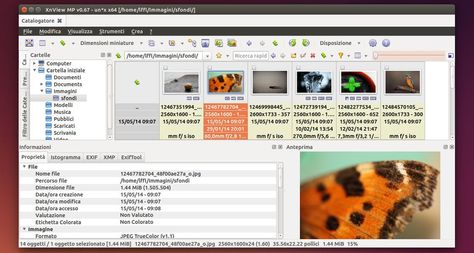


Once installed, open the XnView from Ubuntu Dash or Terminal.
#Xnviewmp debian 32 bit#
To do so, run the command given below: For 32 Bit Ubuntu Voici donc le DEB de la version 64bits de xnviewmp.
#Xnviewmp debian install#
Ubuntu users can also install xnViewMP from DEB packages. Pour toutes les versions de Linux basées sur debian. Sudo sh -c 'echo "deb trusty-getdeb apps" > /etc/apt/sources.list' Open Terminal and run the following command to install xnViewMP on Ubuntu 16.04, Ubuntu 15.04, Ubuntu 14.04 and Derivarives: 220 bytes, 9 lines control 75 bytes, 4 lines. size 27860094 bytes: control archive384 bytes. XnView MP voi lukea yli 500 kuvatiedostomuotoa, mukaan lukien JPEG, PNG, TIFF, GIF ja monet muut. Niille teistä, jotka eivät tienneet, XnView MP on moderni ja monipuolinen mediaselain, kuvankatseluohjelma, kuvanhallinta ja valokuvien koon muuttaja. In addition to the basic viewing and exporting functions, XnView lets you create slideShows web pages, contact sheets, video thumbnails gallery and strip of images. dpkg -I XnViewMP-linux-圆4.deb new debian package, version 2.0. Tässä opetusohjelmassa näytämme sinulle, kuinka XnView MP asennetaan Ubuntu 20.04 LTS. Could somebody please help me with this? It would be really great if I could manage to install it somehow.View Functions – With XnView you can browse, organize, and view your images in numerous ways:Įdit Functions – XnView allows you to process your images with an arsenal of editing tools: Just download and install the Flathub repository file. To get started, all you need to do is enable Flathub, which is the best way to get Flatpak apps. Flatpak is installed by default on Fedora Workstation, Fedora Silverblue, and Fedora Kinoite. I’ve come to depend a lot on this little image viewer/browser, and you can imagine how stressful it was for me to see that it doesn’t want to install today. Follow these simple steps to start using Flatpak.
#Xnviewmp debian how to#
I tried to google for the fix, and on this older manjaro forum someone mentioned a fix, but it doesn’t work in my case (or I don’t know how to implement it correctly): I use XnViewMP for format conversions and light image editing. While I had no issues with installing either of these two on my previous manjaro installations, with this new manjaro both of them give these validity check failures. On the other hand, the basic image viewer included with most Linux desktop environments. One is “regular” (xnviewmp 0.98.3-1) and the other is xnview-system-libs 0.98.3-1. => ERROR: One or more files did not pass the validity check! => Validating source files with sha256sums. When I wanted to install XnView from AUR repository using Pamac, I got this error message: Building xnviewmp. So instead of explaining how to edit Exif metadata on photos in 5 different imaging apps, we will move on to the XnViewMP.

However, accessing these editing features can be confusing, and every desktop has a different Photos app. Today I did a reinstall of Manjaro on my laptop. Many of the photo editors that come in Linux desktop environments can edit Exif data in photos. Debian 8.0 'Jessie' and later (Linux) Fedora 14 and later (Linux) Fink 0.32.1 and later (Mac) FreshPorts (FreeBSD) Gentoo Linux Homebrew (Mac) MacPorts Mageia 2 and later (Linux) MSYS2 (Windows) MXE (M Cross Environment) NetBSD 5.0 and later OpenMandriva (Linux) openSUSE 11.4 and later (Linux) PCLinuxOS Red Hat Enterprise Linux 6.


 0 kommentar(er)
0 kommentar(er)
